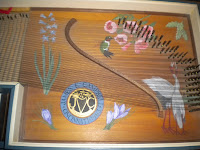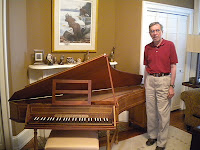


Thanks to a generous scholarship from Catacoustic Consort, I was able to attend a baroque opera workshop in Seattle called Accademia d'Amore. Stephen Stubbs is the Artistic and Musical Director, and his wife, Maxine, is an outstanding triple harp player. To learn from her was the reason I selected this particular workshop as an appropriate one to attend. The workshop was 10 full days in length, and every day was filled from beginning to end with rehearsals and coachings. There were many distinguished continuo players amongst the faculty, so I had the added benefit of learning from them, as well as Maxine. These included Grant Herreid, the founder of the New York Continuo Collective, Elizabeth Brown, Jillon Stoppels Dupree, Margriet Tindemans, and Nancy Zylstra. The interactions did not stop there, since the musical and dramatic elements were so wedded that the continuo groups were also guided by the staging and choreography directors, Giullaume Bernardi, Roger Hyams and Anna Mansbridge. Grant was also a stage director, which goes a long way toward making my point that the staging and musical direction were virtually inseparable. In fact, I did not even realize that Grant was a continuo player until the end of my time there since that was not his principal role during the workshop. I am a little embarrassed to admit that I did not know everyone's very impressive resumes from the start, but my excuse is that I quite intentionally put on blinders and focused on the work I had to do to learn my scenes and as much about continuo and playing the baroque triple harp as I could manage during my time there. I eventually looked up from my music to pay attention to the people around me with the result that I made many wonderful new friends.
There were 3 continuo teams, each comprised of a faculty and student mixture. All teams consisted of a harpsichord, a baroque cellist or viola da gamba, a baroque guitar, and two of the teams had a triple harp. (There was another triple harp player there, an excellent student of Maxine's who lives in the area.) The opera selections were divided amongst the teams. My team played selections from Monteverdi's Poppea, a scene from Cavalli's Calisto, and a scene from Caccini's La Liberazione di Ruggiero dall'Isola d'Alcina. The singers were from all over the world - South Africa, New York, England, Canada, Australia, and about 12 different states in the US.
Our days began with a movement class, led alternately by Anna or Roger. These classes also incorporated baroque gesture instruction. I was extremely fascinated to learn that many of the gestures have survived the centuries and are still in use today in everyday life. We all learned a bit of acting in these classes as well. The rest of the day we rehearsed. Initially, everyone was present for the first readings of all the pieces, then in subsequent days the teams divided up and scattered to various spaces in the school for coachings led by the musical and stage directors. At the end of the day, though my brain had turned to jello, and back in Cincinnati it was bedtime, I would stay and try to practice a while.
I left Cincinnati with a lot of questions and feeling very insecure about the scenes that I had been assigned. Continuo playing is an extremely complex and nuanced art, and learning how to do it is challenging me tremendously, in spite of my extensive experience as an ensemble player and all the work I have done with singers through the years. I am used to a different set of rules, and in many ways it feels like I have to start all over, which is a very humbling thing. Listening to Stephen and Maxine play was the most educational aspect of the experience. Stephen quite often would coach a singer and act as the sole accompanist while he did this, asking the rest of us to hold back a moment so he could work individually with the singer. It was extremely instructive to hear how he supported the singer. Seeing and hearing what he chose to emphasize and what he chose to minimize brought the scores to life in a way that I was not able to see on my own at this early stage. The improvisatory nature of playing continuo brings with it a great deal of freedom, as well as responsibility, since it isn't all spelled out. The score is a mystery, and for the clues we look to the text. Listening to Maxine was greatly inspiring. She gave me a lot of ideas and helped me to find some perspective on how the triple harp would best be utilized within the team. Also, it was extremely helpful to learn that the harpist's approach to interpreting the score varies greatly depending on whether one is a member of a continuo team or the sole support for the singer. There are many colorful ways for the harp to contribute in a team setting and find a place in the texture that do NOT involve playing the bass line! Maxine plays often in the upper registers and departs from the bass line when there are gamba players or a harpsichord present. She often plays huge, voluptuous 4-finger chords in both hands, made more voluptuous by arpeggiations up and down the double outer rows of strings. This is an example of taking advantage of one of the triple harp's unique features and not trying to simply blend into (or, in my case, hide behind) the harpsichord. When Maxine plays, she is heard! She does not simply double what others are doing; what she plays stands out and has its own character. Her playing added spectacularly to the texture and timber. She even played a glissando at the climax of the love duet between Nerone and Poppea. You could have knocked me over with a feather when she did that! I thought I was safe from glissandi in the baroque era, but apparently there is no escape!
You may wonder what instrument I played, if the Catacoustic triple harp made the journey. That was not necessary, as Maxine was kind enough to loan me one of her triple harps! Transporting a harp of any kind is a huge challenge, especially across such a distance. I was grateful that it was not necessary.
To summarize, the workshop was an incredible 10-day immersion into the art of continuo and baroque opera. I left Seattle with a beautiful collection of tunes seared into my brain, filled with inspiration for the journey ahead.
To learn more about Seattle's Accadmia d'Amore, visit http://www.pacificmusicworks.org/education.



























